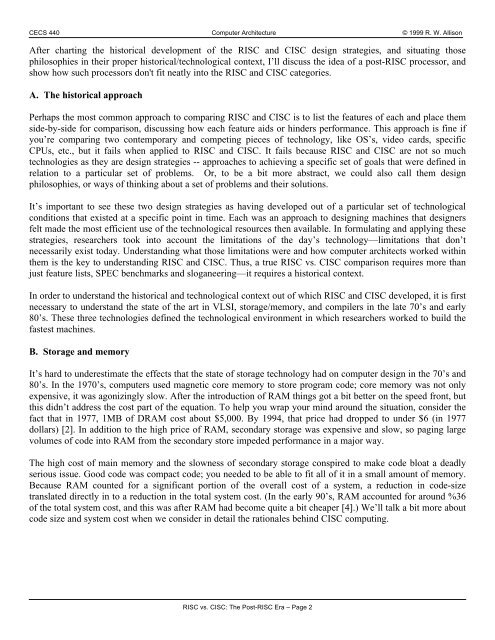RISC vs. CISC
RISC vs. CISC
RISC vs. CISC
Create successful ePaper yourself
Turn your PDF publications into a flip-book with our unique Google optimized e-Paper software.
CECS 440 Computer Architecture © 1999 R. W. Allison<br />
After charting the historical development of the <strong>RISC</strong> and <strong>CISC</strong> design strategies, and situating those<br />
philosophies in their proper historical/technological context, I’ll discuss the idea of a post-<strong>RISC</strong> processor, and<br />
show how such processors don't fit neatly into the <strong>RISC</strong> and <strong>CISC</strong> categories.<br />
A. The historical approach<br />
Perhaps the most common approach to comparing <strong>RISC</strong> and <strong>CISC</strong> is to list the features of each and place them<br />
side-by-side for comparison, discussing how each feature aids or hinders performance. This approach is fine if<br />
you’re comparing two contemporary and competing pieces of technology, like OS’s, video cards, specific<br />
CPUs, etc., but it fails when applied to <strong>RISC</strong> and <strong>CISC</strong>. It fails because <strong>RISC</strong> and <strong>CISC</strong> are not so much<br />
technologies as they are design strategies -- approaches to achieving a specific set of goals that were defined in<br />
relation to a particular set of problems. Or, to be a bit more abstract, we could also call them design<br />
philosophies, or ways of thinking about a set of problems and their solutions.<br />
It’s important to see these two design strategies as having developed out of a particular set of technological<br />
conditions that existed at a specific point in time. Each was an approach to designing machines that designers<br />
felt made the most efficient use of the technological resources then available. In formulating and applying these<br />
strategies, researchers took into account the limitations of the day’s technology—limitations that don’t<br />
necessarily exist today. Understanding what those limitations were and how computer architects worked within<br />
them is the key to understanding <strong>RISC</strong> and <strong>CISC</strong>. Thus, a true <strong>RISC</strong> <strong>vs</strong>. <strong>CISC</strong> comparison requires more than<br />
just feature lists, SPEC benchmarks and sloganeering—it requires a historical context.<br />
In order to understand the historical and technological context out of which <strong>RISC</strong> and <strong>CISC</strong> developed, it is first<br />
necessary to understand the state of the art in VLSI, storage/memory, and compilers in the late 70’s and early<br />
80’s. These three technologies defined the technological environment in which researchers worked to build the<br />
fastest machines.<br />
B. Storage and memory<br />
It’s hard to underestimate the effects that the state of storage technology had on computer design in the 70’s and<br />
80’s. In the 1970’s, computers used magnetic core memory to store program code; core memory was not only<br />
expensive, it was agonizingly slow. After the introduction of RAM things got a bit better on the speed front, but<br />
this didn’t address the cost part of the equation. To help you wrap your mind around the situation, consider the<br />
fact that in 1977, 1MB of DRAM cost about $5,000. By 1994, that price had dropped to under $6 (in 1977<br />
dollars) [2]. In addition to the high price of RAM, secondary storage was expensive and slow, so paging large<br />
volumes of code into RAM from the secondary store impeded performance in a major way.<br />
The high cost of main memory and the slowness of secondary storage conspired to make code bloat a deadly<br />
serious issue. Good code was compact code; you needed to be able to fit all of it in a small amount of memory.<br />
Because RAM counted for a significant portion of the overall cost of a system, a reduction in code-size<br />
translated directly in to a reduction in the total system cost. (In the early 90’s, RAM accounted for around %36<br />
of the total system cost, and this was after RAM had become quite a bit cheaper [4].) We’ll talk a bit more about<br />
code size and system cost when we consider in detail the rationales behind <strong>CISC</strong> computing.<br />
<strong>RISC</strong> <strong>vs</strong>. <strong>CISC</strong>: The Post-<strong>RISC</strong> Era – Page 2











